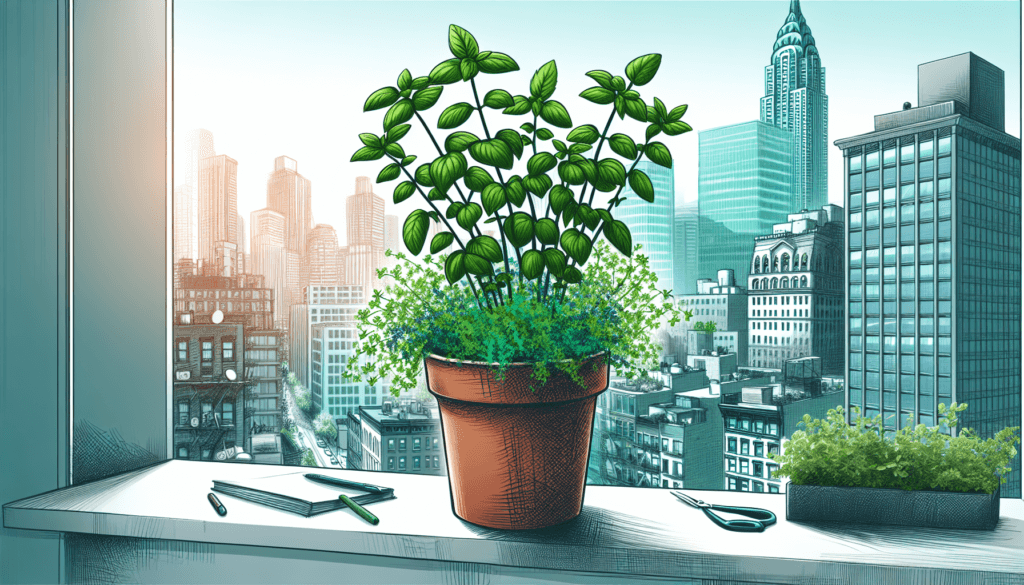Urban gardening is becoming increasingly popular, allowing city dwellers to cultivate their green thumbs even in the concrete jungle. If you’re an urban gardener looking to spice up your green space, look no further than these top five must-have herbs. From the culinary delight of basil to the soothing aroma of lavender, these herbs not only add flavor and fragrance to your dishes, but they also offer a range of health benefits. Whether you have a large backyard or a small balcony, these herbs are sure to thrive in your urban garden and elevate your culinary creations to new heights.

Basil
Overview
Basil is one of the most popular herbs among urban gardeners, and for good reason. With its vibrant green leaves and distinct aroma, basil is a versatile and flavorful herb that can elevate any dish. It belongs to the mint family and is native to the tropical regions of Asia. Basil is commonly used in Italian cuisine but can also be found in Southeast Asian dishes.
Varieties
There are several varieties of basil to choose from, each with its own unique flavor profile. Sweet basil is the most common variety, with a slightly peppery taste and hints of anise. It pairs well with tomatoes, making it a staple in many caprese salads and pasta dishes. There are also purple basil varieties, such as Thai basil, which have a stronger flavor and lend a hint of licorice to dishes.
Growing Tips
Basil thrives in warm weather and requires around six to eight hours of direct sunlight daily. It is best grown from seed, although you can also find starter plants at your local nursery. Plant basil in well-draining soil and water it regularly, allowing the soil to dry out between waterings. To encourage bushier growth, pinch off the top leaves when the plant reaches around six inches in height.
Uses
Basil is a versatile herb that can be used in a variety of dishes. It adds a burst of freshness and flavor to salads, pasta sauces, and pizzas. You can also make basil pesto by blending basil leaves, garlic, pine nuts, Parmesan cheese, and olive oil. Basil leaves can be enjoyed fresh or dried, adding a delightful aroma to soups, stews, and marinades.
Maintenance
To keep your basil plant healthy, regularly pinch off any flowers that appear. This will redirect the plant’s energy into producing more leaves. Remember to harvest basil by removing the top leaves, leaving a few pairs of leaves on the stem to encourage further growth. If you have a surplus of basil, consider freezing it in ice cube trays with a little water or oil for later use.
Mint
Overview
Mint is another must-have herb for urban gardeners. With its refreshing and cooling properties, mint is a delightful addition to both sweet and savory dishes. There are many varieties of mint, each with its own unique flavor profile and characteristics. It is a fast-growing herb that is known for its ability to spread quickly, so it’s best to grow mint in containers to prevent it from taking over your garden.
Popular Varieties
Spearmint and peppermint are the most common varieties of mint. Spearmint has a mild and slightly sweet taste, making it a popular choice for teas, cocktails, and desserts. Peppermint, on the other hand, has a stronger and more cooling flavor, making it a great addition to chocolate dishes and savory recipes, such as lamb or Middle Eastern cuisine. Other varieties, such as chocolate mint and apple mint, offer unique flavor profiles that can add a twist to your culinary creations.
Growing Tips
Mint thrives in partial shade and moist soil. It can tolerate a wide range of soil types, making it a great herb for beginners. When planting mint, it is best to use containers to prevent it from spreading and taking over your garden. If you prefer to plant it in the ground, consider using a barrier around the plant’s roots to contain its growth. Remember to water mint regularly and pinch off any flowers to encourage leaf production.
Uses
Mint is often associated with desserts and beverages, such as mint chocolate chip ice cream and mint juleps. However, its uses go beyond that. Mint leaves can be added to salads, roasted vegetables, and fruit salads to add a refreshing twist. You can also infuse mint leaves in hot water to make a soothing and digestive herbal tea. Additionally, mint can be used as a natural pest repellent or to freshen your breath.
Maintenance
Mint is a relatively low-maintenance herb, but it does require regular maintenance to keep it healthy. To prevent mint from spreading uncontrollably, regularly trim the plant and remove any runners that venture outside the container or designated area. Harvest mint leaves regularly by snipping off the top leaves. This will promote bushier growth and prevent the plant from becoming leggy. To keep your mint plant looking its best, water it consistently and monitor for any signs of pests or diseases.

Rosemary
Overview
Rosemary is a fragrant and flavorful herb that is commonly used in Mediterranean cuisine. Its needle-like leaves and woody stems make it a visually appealing addition to any garden. Rosemary is a perennial herb that can survive in various climates, making it a great choice for urban gardeners.
Varieties
There are several varieties of rosemary, each with its own unique flavor profile. Common rosemary is the most widely available variety, known for its strong and pine-like aroma. There are also dwarf rosemary varieties, such as ‘Prostratus’ and ‘Blue Spires,’ which are ideal for container gardening. These varieties have a cascading growth habit, making them visually appealing in hanging baskets or window boxes.
Growing Tips
Rosemary thrives in sunny and well-draining soil. It is a drought-tolerant herb that does not require excessive watering. Allow the soil to dry out between waterings, but do not let it become bone dry. Rosemary is best grown from cuttings, although starter plants can also be found at nurseries. Prune rosemary regularly to maintain its shape and promote bushier growth.
Uses
Rosemary is a versatile herb that can add depth and aroma to a wide range of dishes. Its robust flavor pairs well with roasted meats, such as lamb, chicken, and pork. You can also infuse olive oil with rosemary to create a fragrant and flavorful condiment for dipping bread or drizzling over salads. The woody stems of rosemary can be used as skewers for kebabs, imparting a subtle herbal flavor to the grilled ingredients.
Maintenance
Rosemary is a relatively low-maintenance herb, but it does require occasional care to keep it healthy. Prune rosemary regularly to prevent it from becoming leggy and to encourage new growth. Trim any dead or diseased branches to maintain the plant’s overall health. Rosemary is a perennial herb that can benefit from an annual nutrient boost in the form of compost or organic fertilizer. Monitor for any signs of pests or diseases and take appropriate action if necessary.
Thyme
Overview
Thyme is a versatile herb that is commonly used in Mediterranean, Middle Eastern, and European cuisines. With its small, aromatic leaves and delicate flowers, thyme adds a subtle earthiness to dishes. It is a perennial herb that is relatively easy to grow, making it a great choice for urban gardeners.
Varieties
There are several varieties of thyme, each with its own unique flavor profile. Common thyme, also known as English thyme, is the most widely available variety and has a mild and slightly minty taste. Lemon thyme has a citrusy flavor and pairs well with seafood and poultry dishes. Other popular varieties include caraway thyme, which has a subtle anise flavor, and creeping thyme, which is ideal for ground cover and rock gardens.
Growing Tips
Thyme thrives in well-draining soil and requires around six hours of direct sunlight daily. It can tolerate drought and does not require excessive watering. Plant thyme from seed or starter plants, ensuring that they are spaced at least eight inches apart. Thyme can also be propagated from cuttings. Prune thyme regularly to maintain its shape and to prevent it from becoming woody.
Uses
Thyme is a versatile herb that can be used in a variety of dishes. Its earthy flavor pairs well with roasted meats, stews, and soups. You can also add thyme to marinades and dressings to enhance their flavor. Thyme leaves can be used fresh or dried, imparting a delightful aroma to herbal teas and infused oils. Additionally, thyme can be incorporated into DIY cleaning products due to its natural antimicrobial properties.
Maintenance
Thyme is a relatively low-maintenance herb, but it does require regular care to keep it healthy. Prune thyme regularly to promote bushier growth and prevent it from becoming woody. Remove any dead or diseased branches to maintain the plant’s overall health. Thyme is a perennial herb that can benefit from an annual feeding of compost or organic fertilizer. Water thyme sparingly, allowing the soil to dry out between waterings. Monitor for any signs of pests or diseases and take appropriate action if necessary.

Parsley
Overview
Parsley is an herb that is often used as a garnish, but it offers much more than just aesthetics. With its vibrant green leaves and fresh taste, parsley can elevate the flavors of many dishes. It belongs to the same family as carrots and celery and is native to the Mediterranean region. Parsley is a biennial herb, meaning it completes its life cycle in two years.
Varieties
There are two main varieties of parsley: curly parsley and flat-leaf (Italian) parsley. Curly parsley has tightly curled leaves and is often used as a garnish. Flat-leaf parsley, also known as Italian parsley, has broader leaves and a stronger flavor. It is more commonly used in cooking and has a more robust taste compared to curly parsley.
Growing Tips
Parsley thrives in well-draining soil and prefers partial shade to full sun. It can be grown from seeds or starter plants. It is important to note that parsley seeds can be slow to germinate, so be patient and keep the soil consistently moist. Once the seedlings are established, thin them out to allow proper airflow and prevent overcrowding. Regularly remove any yellow or dead leaves to promote healthy growth.
Uses
Parsley is a versatile herb that can be used in both raw and cooked dishes. It adds a bright and fresh flavor to salads, soups, and sauces. Flat-leaf parsley is often preferred in cooking, as it withstands heat better and retains its flavor. Parsley can also be used as a decorative garnish or as a key ingredient in pesto sauces. Additionally, it can provide a natural breath freshener when chewed.
Maintenance
Parsley requires regular maintenance to keep it healthy and promote continuous growth. Regularly prune parsley by removing the outer leaves, leaving the inner leaves to continue growing. This will ensure a constant supply of fresh leaves for your culinary creations. Water parsley consistently, keeping the soil consistently moist but not waterlogged. Monitor for any signs of pests or diseases and take appropriate action if necessary. As a biennial herb, parsley will produce flowers and seeds in its second year before completing its lifecycle.
Chives
Overview
Chives are a versatile herb with slender, hollow leaves and delicate purple flowers. Known for their mild onion flavor, chives are often used as a garnish or added to various dishes for a pop of freshness. They are part of the allium family, which includes onions, garlic, and leeks.
Varieties
Common chives, or Allium schoenoprasum, are the most widely available variety and are known for their mild flavor. They have slender, tubular leaves and grow in clumps. Garlic chives, or Allium tuberosum, have a stronger flavor and a hint of garlic. They have flat leaves and are often used in Asian cuisine for their distinctive taste.
Growing Tips
Chives prefer full sun but can tolerate partial shade. They require well-draining soil enriched with organic matter. Chives can be grown from seeds or starter plants. When planting chives, space them at least six inches apart to allow for proper air circulation. Water them consistently, allowing the soil to dry out between waterings. Regularly snip off the outer leaves to encourage new growth.
Uses
Chives can be used in a variety of dishes to add a mild onion flavor. They are often used as a garnish for soups, salads, and baked potatoes. Chives can be chopped and added to omelets, scrambled eggs, and creamy dips for a burst of freshness. Garlic chives are commonly used in Asian cuisine and can be added to stir-fries and dumplings for their unique taste.
Maintenance
Chives are relatively easy to grow and require minimal maintenance. Regularly trim the outer leaves to promote new growth and prevent the plant from becoming leggy. Snip the leaves close to the base using sharp scissors or garden shears. Chives can benefit from an annual feeding of compost or organic fertilizer to ensure optimal growth. Water them consistently, but avoid overwatering to prevent root rot. Monitor for any signs of pests or diseases and treat accordingly.

Cilantro
Overview
Cilantro, also known as coriander in some parts of the world, is an herb with delicate, feathery leaves and a pungent flavor. It is commonly used in various cuisines, including Mexican, Indian, and Southeast Asian dishes. Cilantro is known for its divisive taste, with some people loving its vibrant flavor and others finding it overpowering.
Varieties
There is only one variety of cilantro, but the plant produces two distinct parts that are commonly used in cooking. The leaves, also known as cilantro, have a strong and distinct flavor. The seeds, known as coriander seeds, have a warm, nutty flavor and are often ground and used as a spice.
Growing Tips
Cilantro is a cool-weather herb that prefers full sun to partial shade. It can be grown from seeds or starter plants. When planting cilantro from seeds, sow them directly in the ground or a container as they do not transplant well. Cilantro prefers well-draining soil and requires consistent moisture. Regularly remove any yellow or dead leaves to promote healthy growth.
Uses
Cilantro is a versatile herb that can be used in a variety of dishes. Its fresh and citrusy flavor pairs well with Mexican dishes, such as salsa and guacamole. Cilantro leaves can be used as a garnish for soups, curries, and rice dishes. The seeds, coriander, can be ground and used as a spice in various recipes, adding a warm and nutty flavor. Some people enjoy the leaves while others find them too pungent; it all comes down to personal preference.
Maintenance
Cilantro requires regular maintenance to ensure continuous growth and prevent it from bolti


